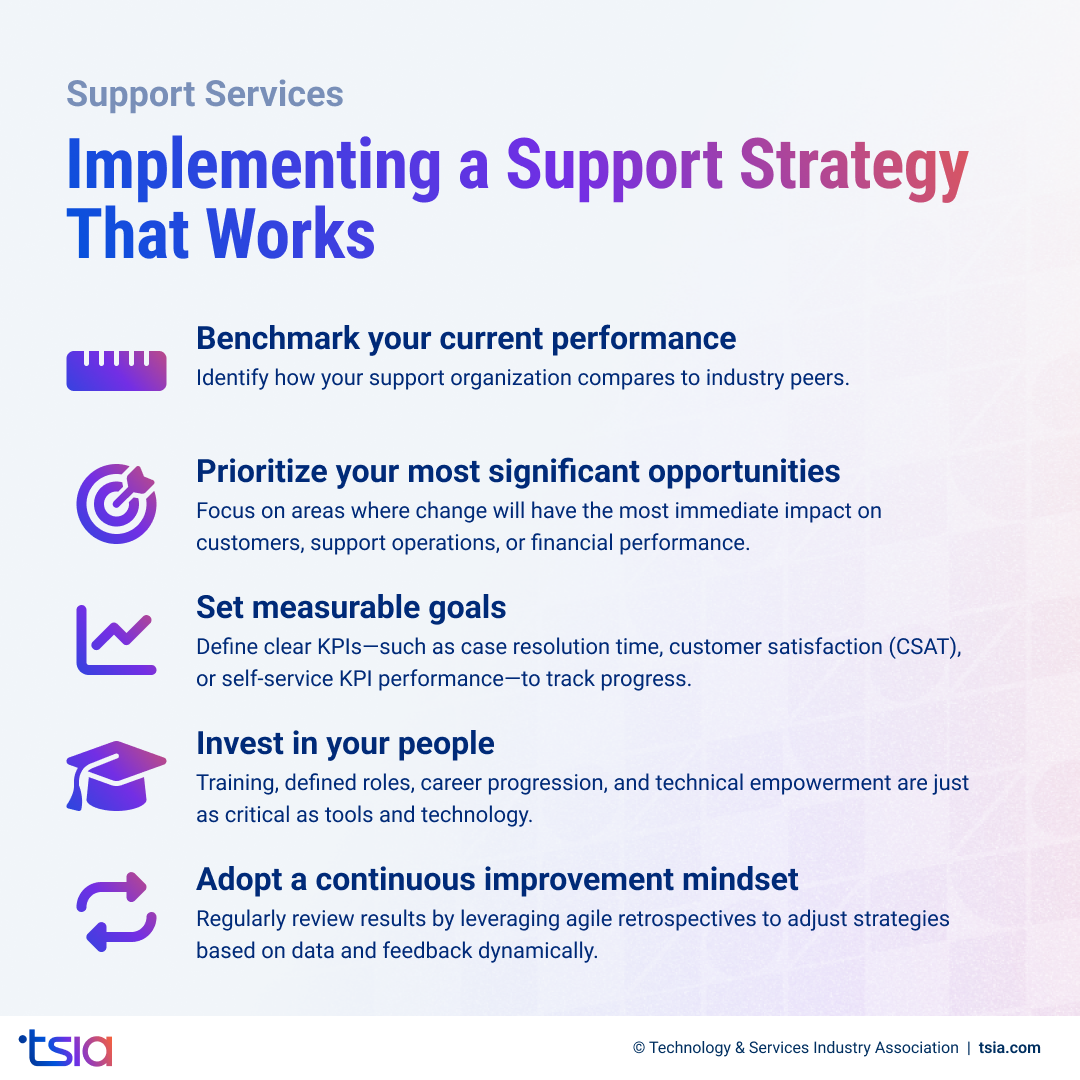When your customers encounter a problem, where do they turn? The answer defines not only their experience, but also your company’s reputation. Support services are the backbone of that experience—the bridge between your products and the people who rely on them every day.
In today’s technology-driven world, support organizations are no longer just viewed as cost centers. They’re strategic assets—essential to customer retention, satisfaction, and growth. Whether you deliver software, hardware, or XaaS solutions, your support services determine how effectively you help customers succeed.
So, what are support services? And how can you build a world-class support organization that consistently delivers value? Let’s explore.
Key Takeaways
- Support services are the strategic backbone of customer experience. They help customers use your products successfully, resolve issues quickly, and drive brand loyalty for your company.
- World-class support organizations don’t just react—they evolve. By leveraging proven frameworks, you can transform your support function into a growth engine that drives your business's annual recurring revenue (ARR).
- Support excellence starts with structure. Consistent, proven frameworks provide your team with the clarity, data, and best practices needed to deliver measurable business results.
Understanding What Support Services Are
At its core, support services encompass all the activities your organization provides to help customers use your technology effectively and resolve issues efficiently. From technical troubleshooting and case management to knowledge sharing and proactive outreach, support services ensure that customers extract maximum value from your products.
But today, support is much more than answering tickets. It’s about building trust and creating a seamless connection between your customers, your products, and your company’s success. When designed strategically, support becomes an extension of your product experience and a driver of customer loyalty, renewals, and recurring revenue.
Why Support Services Matter More Than Ever
Technology continues to grow in complexity, and customer expectations have never been higher. Your customers expect 24/7 access to help, fast resolutions, and intelligent self-service options powered by AI. That’s why world-class support organizations must continuously evolve. They need to:
- Move beyond reactive issue resolution to proactive problem prevention.
- Use AI and analytics to personalize and predict customer needs.
- Align closely with product teams to improve serviceability and usability.
- Leverage structured frameworks and benchmarks to guide operational excellence.
The result? More efficiency, higher scalability, happier customers, and a stronger, more resilient business model.
Building a World-Class Support Organization
Creating a high-performing support organization doesn’t happen by accident. It requires focus, structure, consistency, and strategy.
At a high level, building a world-class support organization involves focusing on five key areas.
1. Optimizing Your Business Model
Your support organization can—and should—be more than a cost center. Optimizing your business model means evolving support into a growth engine by aligning it with your company’s strategic goals.
This involves examining how support impacts profitability, identifying where it drives customer retention, and ensuring that it integrates with other service functions. When support contributes directly to business outcomes, it becomes an essential part of your organization’s success story.
2. Managing Costs Without Sacrificing Value
Being efficient and cost-conscious will always be important—but cutting costs shouldn’t come at the expense of quality.
The most effective support organizations balance cost and customer experience by:
- Streamlining case management and escalation processes.
- Clearly defining roles and responsibilities across teams.
- Encouraging collaboration and knowledge sharing to reduce time-to-resolution.
These practices help you scale sustainably while achieving service levels your customers expect.
3. Turning Support Into a Growth Engine
Support services aren’t just about solving problems, they’re opportunities to strengthen relationships and expand revenue.
Every customer interaction provides insights into product usage, satisfaction, and potential upsell or renewal opportunities. By capturing and analyzing these insights, you can identify patterns that drive value and create premium support offerings that customers are willing to invest in.
When executed effectively, support becomes a driver of annual recurring revenue and a trusted extension of your brand promise.
4. Connecting Support and Product Teams
When your support and product teams collaborate seamlessly, everyone wins.
Support provides invaluable feedback about product usability, recurring issues, and customer needs. Product teams, in turn, can use this feedback to improve quality, simplify the customer experience, and reduce future support demand.
Establishing a strong connection between these teams ensures that customers benefit from continuous improvement—and your organization gains operational efficiency.
5. Integrating AI and Self-Service
Artificial intelligence and self-service technologies have completely changed the landscape of customer support.
AI tools can analyze thousands of cases to identify trends, analyze sentiment, predict issues before they happen, and deliver instant answers through conversational chatbots and virtual assistants. Meanwhile, modern self-service platforms empower customers to find solutions quickly, freeing your agents to focus on solving more complex challenges.
The key is balance: using technology to scale without losing the human touch. The best support organizations use AI to enhance—not replace—the expertise and empathy that define excellent service.
Related: Modern Support at Scale
Implementing a Support Strategy That Works
Knowing what great support looks like is one thing. Implementing it effectively is another.
Start by assessing where your organization stands today. What’s working? Where are the bottlenecks? Consider these steps to lay a solid foundation:
- Benchmark your current performance. Identify how your support organization compares to industry peers.
- Prioritize your most significant opportunities. Focus on areas where change will have the most immediate impact on customers, support operations, or financial performance.
- Set measurable goals. Define clear KPIs—such as case resolution time, customer satisfaction (CSAT), or self-service KPI performance—to track progress.
- Invest in your people. Training, defined roles, career progression, and technical empowerment are just as critical to tools and technology.
- Adopt a continuous improvement mindset. Regularly review results by leveraging agile retrospectives to adjust strategies based on data and feedback dynamically.

Related: TSIA Support Services Benchmarking
Common Challenges (and How To Overcome Them)
Transforming your support organization comes with challenges, but each can be managed with the right approach.

Building a world-class support organization isn’t about one significant change. It’s about consistent, data-driven improvements that manifest in ongoing people, processes, and technology transformations that can result in one, and only one outcome: exceptional customer experience and value creation.
Related: The State of Support Services 2025
Your Path to Support Services Excellence
Building a world-class support organization is a continuous journey, not a one-time project. By focusing on structure, strategy, and data-driven improvement, you can elevate your support organization from reactive problem-solving to proactive customer success.
The payoff is clear: lower costs, higher satisfaction, and more substantial recurring revenue. Your support organization becomes more than a function—it becomes a foundation for growth and long-term customer loyalty.
FAQs
What exactly are support services?
Support services are the processes, systems, and people dedicated to helping customers use your technology successfully. This includes technical support, troubleshooting, case management, and proactive customer enablement.
Why are support services essential?
They directly impact customer satisfaction, retention, and profitability. Superlative support services keep customers engaged, reduce churn, and help differentiate your company in a competitive market.
How can I improve my organization’s support services?
Start by benchmarking your performance, defining clear goals, and implementing structured best practices that focus on scalability, efficiency, collaboration, and continuous improvement.
Smart Tip: Embrace Data-Driven Decision Making
Making smart, informed decisions is more crucial than ever. Leveraging TSIA’s in-depth insights and data-driven frameworks can help you navigate industry shifts confidently. Remember, in a world driven by artificial intelligence and digital transformation, the key to sustained success lies in making strategic decisions informed by reliable data, ensuring your role as a leader in your industry.












